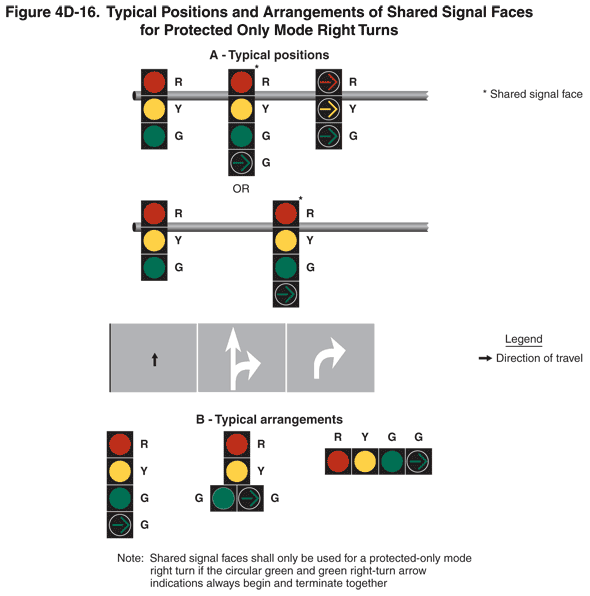|
|
2009 Edition Part 4 Figure 4D-16. Typical Positions and Arrangements of Shared Signal Faces for Protected Only Mode Right Turns

Figure 4D-16. Typical Positions and Arrangements of Shared Signal Faces for Protected Only Mode Right Turns
This figure shows the typical positions and arrangements of shared signal faces for protected only mode right turns. A legend shows a black arrow indicating the direction of travel on the roadway. A note states: "Shared signal faces shall only be used for a protected-only mode right turn if the circular green and green right-turn arrow indications always begin and terminate together."
The figure shows two types of examples. The first example is labeled "A – Typical Positions." It shows three signals aligned horizontally on a horizontal pole over a vertical segment of three lanes of a roadway. An upward-pointing black arrow is shown in the left lane denoting the direction of travel as straight through, a white combined straight ahead and right-turn arrow is shown marked in the middle lane, and a white right-turn arrow is shown marked in the right lane. The left signal is shown above the left lane as a vertical arrangement of circular red, circular yellow, and circular green signal indications. The middle signal (noted as shared signal face) is shown above the center lane as a vertical arrangement of circular red, circular yellow, circular green, and right-turn green arrow signal indications. The right signal is shown above the right-turn lane as a vertical arrangement of right-turn red arrow, right-turn yellow arrow, and right-turn green arrow signal indications. Below these signals, the word "OR" is shown and another set of signals. Two signals are shown aligned horizontally on a horizontal pole. The left signal is shown above the left lane as a vertical arrangement of circular red, circular yellow, and circular green signal indications. The right signal (noted as shared signal face) is shown centered above the white line separating the center and right lanes as a vertical arrangement of circular red, circular yellow, circular green, and right-turn green arrow signal indications.
The second type of example is labeled "B – Typical Arrangements." It shows three arrangements. The left arrangement shows a vertical arrangement of four signal indications - circular red, circular yellow, circular green, and right-turn green arrow. The middle arrangement shows a vertical arrangement of circular red and circular yellow signal indications centered above a horizontal arrangement of a circular green signal indication to the left of a right-turn green arrow signal indication. The right arrangement shows a horizontal arrangement of the same four signal indications.
